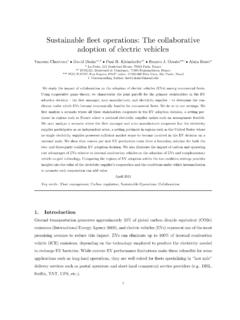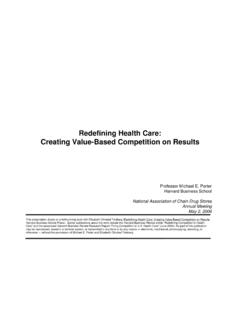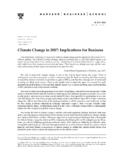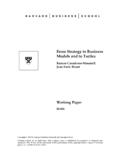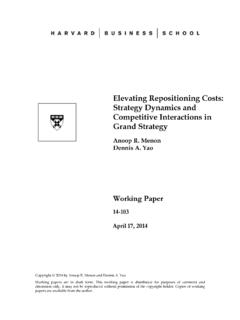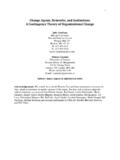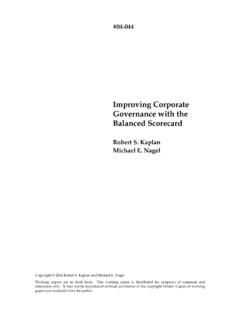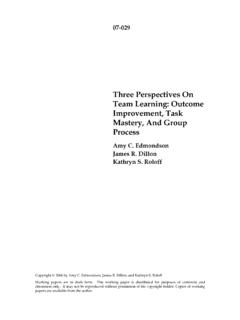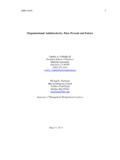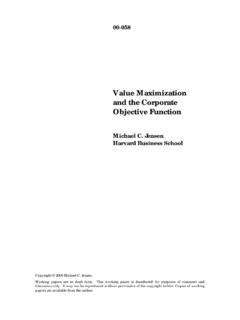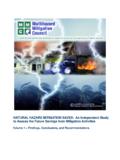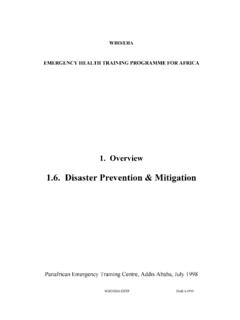Transcription of The Political Economy of “Natural” Disasters
1 Copyright 2008 by Charles Cohen and Eric Werker Working papers are in draft form. This working paper is distributed for purposes of comment and discussion only. It may not be reproduced without permission of the copyright holder. Copies of working papers are available from the author. The Political Economy of natural Disasters Charles Cohen Eric Werker Working Paper 08-040 The Political Economy of natural Disasters Charles Cohen Vice President, Sankaty Advisors, Boston MA Eric Werker Assistant Professor, Harvard Business School, Boston MA 2008 ABSTRACT natural Disasters occur in a Political space. Although events beyond our control may trigger a disaster , the level of government preparedness and response greatly determines the extent of suffering incurred by the affected population. We use a Political Economy model of disaster prevention, supported by case studies and preliminary empirics to explain why some governments prepare well for Disasters and others do not.
2 We show how the presence of international aid distorts this choice and increases the chance that governments will under-invest. Policy suggestions that may alleviate this problem are discussed. Key Words: natural Disasters ; Humanitarian Aid; Samaritan s Dilemma. 2I. INTRODUCTION natural Disasters occur in a Political space. They are not driven by politics, nor are they immune from politics. Incentives faced by human actors can affect the prevention, mitigation , and damage of natural Disasters , even if they cannot affect the likelihood of rainfall in a specific area or seismic activity along a particular fault line. This is hardly controversial. The vast literature on disaster prevention and response has appreciated the Political dimension of Disasters for decades (Olson, 2000; Platt, 1999; Blaikie et al, 1994; Albala-Bertrand, 1993; Bommer, 1985; Cuny, 1983; Davis and Seitz, 1982; Diggins, Wright, and Rossi, 1979; Abney and Hill, 1966).
3 There is empirical evidence of the relationship: in the United States, Political considerations may explain half of all federal disaster relief (Garrett and Sobel, 2003) and electoral factors influence whether a president issues a disaster declaration (Reeves, 2005); around the world, Disasters tend to be more severe in poorer countries that are poorly run (Stromberg, 2007; Kahn, 2005). This paper represents the first attempt to synthesize these observations into a formal model of disaster mitigation that contains empirical predictions on the severity of Disasters . In addition, this paper is the first to systematically incorporate the Political aspect of disaster in the heart of the model and recognize the feedback between policy interventions and the seriousness of the Disasters themselves. By bringing free relief to countries afflicted by so-called natural Disasters , international humanitarians can create problems of moral hazard with a time-inconsistency nature.
4 In the event of a government being ill prepared for a disaster , international relief effectively rewards bad behavior on the part of the poor countries governments. We adopt a precise, mathematical definition of disaster when the model is introduced in Section Our definition is in spirit with Erikson (1976): [ Disasters ] involve considerable 3harm to the physical and social environment; they happen suddenly or are socially defined as having reached one or more acute stages; and something can be done to mitigate their effects before or after they happen (quoted in Kreps, 1998: 33). In other words, Disasters involve a stochastic negative shock whose severity can be affected through a process of prevention and relief. It is precisely that process that we model. Henceforth, shock refers to the natural act itself the volcanic eruption, earthquake, drought, etc. and disaster refers to the net impact of the shock on the population.
5 natural Disasters have killed over 62 million people world-wide since 1900 (OFDA/CRED 2003). This is approximately the same number as all those killed in both World Wars,2 yet scarce attention has been paid to natural Disasters in the economics and Political science literature, while dozens of articles on conflict are published each year. Over 85 percent of the deaths occurred between 1900 and 1950, and a little over one million deaths from natural Disasters have occurred since Certainly part of the credit for the relatively small number of disaster deaths in the last decade is due to the efforts of the global humanitarian community, and to its ever-increasing resources and effectiveness. In the month of October 2005 alone, international humanitarians and national Red Cross chapters responded to natural Disasters in the Central African Republic, Costa Rica, El Salvador, Guatemala, India, Indonesia, Mexico, Nicaragua, Pakistan, Paraguay, Romania, and the Sudan (Reliefweb 2005).
6 In this paper, we take as given that the relevant actors work in a Political space, and we model that space using a reduced-form framework. National governments care about the social welfare of their citizens, but also want to maximize government income. These governments can spend on both preventative and palliative measures to lessen the impact of a potential natural shock. International humanitarian organizations can step in with ex-post relief to poor countries 4that experience natural Disasters . This setup produces a number of important results, some of which have been independently noted in different strands of the literature. The model predicts that rich governments and governments that care about social welfare spend more on disaster prevention and mitigation . Governments can use natural Disasters to redistribute power through the Political effect, favoring disaster spending in regions that are politically aligned with the party in power.
7 Governments are less prone than local populations to insure against Disasters through preventative measures, because a regional shock has less impact on the national government s income than on that of the local region. The addition of humanitarian aid to the model produces a bailout effect: governments under-invest in disaster prevention when they know that they will be bailed out in the event of disaster . This effect is mitigated for pariah states, which may not have access to international aid. In the extreme, we can witness a racket effect, where governments can deliberately neglect a population so as to attract and steal humanitarian aid in the event of a disaster . Governments without other sources of external income are more likely to be influenced by the racket effect. In addition, in the case of shocks that decimate local populations, international organizations will tolerate higher levels of theft to deliver urgently needed aid.
8 This can lead to a desperation effect: in dire circumstances, rapacious governments have a stronger ability to increase their level of theft. These results have policy implications for reducing the severity of natural Disasters . First, the international humanitarian community must be involved in disaster prevention if it is to offer free relief. Second, whenever possible, disaster relief should be provided locally so as to reduce the significance of the racket and Political effects on the central government. Third, Political development, in the form of more responsive governments and less intrastate conflict, 5will reduce the severity of Disasters . Fourth, in particularly problematic areas, governments can be given extra payments for proper disaster preparation, including establishing and enforcing efficient regulations. This paper is related to two large bodies of research in Political science: Political Economy of war and foreign aid.
9 In essence, Disasters can be used as a blunt policy instrument to target or reward populations and to enrich a government, and they can be mitigated with outside effort. Corollary works on the Political Economy of war include investigations into why the state might target its own population (Valentino, Huth, and Balch-Lindsay, 2004; Harff, 2003; Krain, 1997), and the effectiveness of benevolent outside intervention on internal conflict (Doyle and Sambanis, 2000; Paris, 1997; Diehl, Reifschneider, and Hensel, 1996). By highlighting the potential of foreign assistance to affect domestic outcomes we are adding to a rich literature on the distortionary impact of foreign aid that has hitherto focused on non- disaster aid (Goldsmith, 2001; Br utigam, 2000; Lancaster, 1999; Uvin, 1998). The rest of the paper is organized as follows. In Section II, the model is presented and the terms are defined. Section III solves the model in the case of no outside humanitarian relief, while Section IV allows for external disaster aid.
10 Policy implications and conclusions are offered in Section V. II. A Political MODEL OF Disasters Before making any predictions on the severity of Disasters we set up the model from which the results will be derived. A. Disasters , Prevention, and Relief 6 Assume that a natural shock, such as an earthquake or hurricane, strikes with an exogenous probability q, and causes monetary damage k. We assume that governments cannot control the probability of such a shock, only the shock s impact. We model the impact of the shock as a per capita loss ()abfk, , where f(b,a) is the total level of relief from preventative spending done before the shock hits (b) and palliative spending done after the shock hits (a). We assume that f is concave. Preventative and palliative spending may either be complements (that is, a dollar spent on prevention increases the benefit of a dollar spent on relief, a dam) or substitutes (spending on prevention decreases the per-dollar benefit of spending on relief, famine relief), and this will play a key role in our analysis.
